ShipwreckHunter
Jr. Member
- Joined
- May 15, 2015
- Messages
- 38
- Reaction score
- 137
- Golden Thread
- 0
- Location
- Dallas, Texas
- Detector(s) used
- Garrett Master Hunter
GTI 2500
Infinium LS
Sea Hunter II
Pro-Pointer AT
- Primary Interest:
- Shipwrecks
- #1
Thread Owner
As Florida's Treasure Coast prepares to commemorate one of the most dramatic ship disasters in its history – circa 1715 – experts believe there is still an estimated $280 million in treasure remaining to be found on the ocean's floor off Fort Pierce.
In the regional waters around Fort Pierce, an armada of Spanish ships loaded with gold and silver bars and primitive gold jewelry was thrashed by a fierce hurricane and 10 vessels sank. Also, it is speculated that smuggled emeralds which, according to experts, could exceed half a billion dollars and the private jewelry collections of clergy members still remain submerged.
The 1715 Treasure Fleet was a Spanish armada from the New World to Spain. In the evening of July 30, seven days after departing from Havana, Cuba, steering a northward course parallel to the east coast of Florida, the hurricane struck. Because the fleet was carrying silver, it is also known as the 1715 Plata Fleet (plata being the Spanish word for silver plate).
Some artifacts and coins still wash up on Florida beaches from time to time today.
About 1,000 sailors perished while a small number survived on lifeboats. Many ships, including pirates, took part in the initial salvage. Initially a privateer, Henry Jennings, was first accused of piracy for attacking such salvage ships and claiming their salvages.
The armada was organized by the Spanish government at the port of Cadiz in 1713 just following the end of the War of the Spanish Succession, which had caused the postponement of the regular yearly sailing of the Plate Fleet for several years. Because there were not enough naval vessels available for the undertaking, the king had given orders to make up the balance by letting contracts to private owners. These registros, as they were known, were in charge of Don Antonio de Echebera y Zubiza, while Don Juan Esteban de Ubilla was designated leader of the flota.
During the more than 200 years that the Spanish had been carrying the wealth of the New World to Spain, it had become the custom for the fleets to split upon reaching the western side of the Atlantic, the Galeones de Tierra Firme, or mainland fleet, going to Cartagena and Porto-bello in New Granada and Panama, and the Flota heading for Vera Cruz in New Spain.
From the South American ports the Galeones would pick up shipments of gold, silver and jewels, while the Flota at Vera Cruz collected the gold and silver of Mexico as well as the treasures from the Orient, which arrived there by muleback after a long voyage across the Pacific from Manila in the Philippines to Acapulco.
Finally rendezvousing at Havana, the combined fleets would prepare for the final voyage back to Spain, generally north through the Bahama channel and then northeast past Bermuda to the home port. It was this final leg of the voyage that so often spelled disaster, for even though they were able to navigate the dangerous Gulf Stream, passage between the Bahamas and the reefs that bordered the Florida coast in good sailing weather, it was quite another story when the clumsy ships were caught in the violent winds and seas of a hurricane. And strangely, most sailings from Havana seemed to take place during the hurricane season from July to October.
True to form, the 1715 Combined Armada of 11 ships finally completed its preparations and set sail from Havana on July 24. On July 30 the fleet passed the mouth of the Bahama Channel where it was overtaken by one of those frightening air flurries that are common to the circular course of low pressure systems. The peak of the hurricane struck about 2 a.m. on July 31 with a violent wind from the east northeast while the fleet was offshore between the St. Lucie River and Cape Canaveral. Of the 11 ships in the fleet only one survived, the French Grifon, which had been forced to accompany the flotilla from Vera Cruz so that the fleet's whereabouts would not be betrayed to enemy ships. She was evidently far enough east to make it possible for her to keep clear of the cape.
According to historical accounts, of the ships that were lost, La Francesa and San Miguel under Cmdr. Echevera disappeared completely in the high waves, while the remaining eight were crushed in the shallow waters of Palmar de Ays on Cape Canaveral. General Ubilla and possibly a thousand others died.
The Capitana, flagship of the Commanding General, was lost with General Ubilla and 225 persons; and the Almiranta, 6 flagship of the Admiral under Ubilla, ran aground only a stone's throw from the coast with the loss of 123 men.
Almiranta of Echevera completely broke up with the loss of 124 men. Nuestra Senora de la Concepci6n, which was captained by Don Manuel de Echevera, son of the Commander, disappeared with the loss of 135 men. Urca de Lima ended up in the mouth of a river but lost 35 men. Nuestra Seiora del Carmen, which was known as La Holandesa under Don Antonio de Echevera was set on land and did not suffer.
Centuries passed. After a hurricane in 1955 carried away about 15 feet of the sand bank facing the Florida coast, coins and other evidences of the ancient shipwrecks were uncovered. Kip Wagner, a housebuilder who lived in the vicinity a good part of his life, became curious as to their origin and learned the story of the lost Plate Fleet. He obtained a metal detector and started a search that led him to a re-discovery of the site. Within a half acre he turned up clusters of cannon balls, ship's spikes, quantities of broken earthenware, bits of melted gold and even a pair of cutlasses buried in the sand. A gold ring set with a large, crudely cut diamond and smaller stones was one of the most exciting finds.
His curiosity aroused as to what might lie in the offshore waters, he set out to organize a search first by plane and then by boat. Since then Kip Wagner and his associates who later joined him in forming the Real "8" Company, Inc. and obtaining leases from the state of Florida to work these areas, have located several and salvaged two of the lost Plate ships retrieving an unbelievable treasure in gold and silver coins and bullion, rare Chinese porcelains still intact, jewelry, religious medals and a wide variety of ships' parts and equipment.
Explorations and salvage operations continue to this day since only six of the 11 sunken ships have been found. They appear to be scattered many miles apart in an area from south of Melbourne to south of Fort Pierce. According to experts, vast quantities of Spanish American gold and silver cobs, more gold than found in any other shipwrecks before or since could still remain on the ocean's floor.
According to Florida State law, 25 percent of any treasure trove must become the property of the State.
Treasure Coast celebrates historic shipwrecks - TC Palm
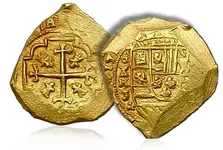
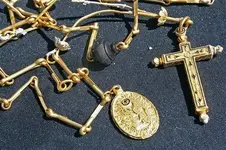
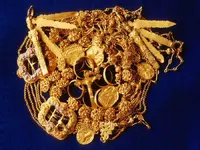
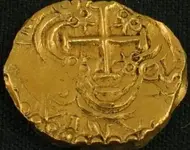
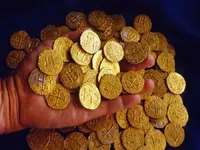
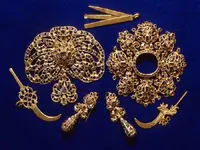
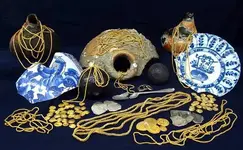
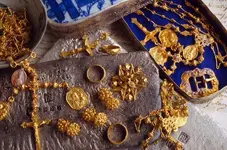
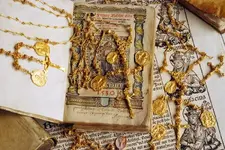
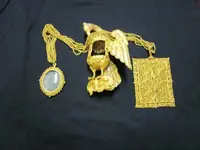
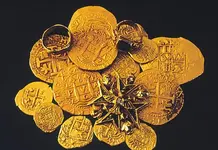
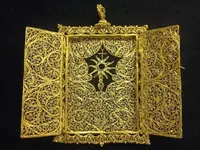
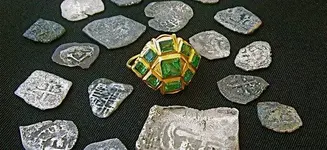
In the regional waters around Fort Pierce, an armada of Spanish ships loaded with gold and silver bars and primitive gold jewelry was thrashed by a fierce hurricane and 10 vessels sank. Also, it is speculated that smuggled emeralds which, according to experts, could exceed half a billion dollars and the private jewelry collections of clergy members still remain submerged.
The 1715 Treasure Fleet was a Spanish armada from the New World to Spain. In the evening of July 30, seven days after departing from Havana, Cuba, steering a northward course parallel to the east coast of Florida, the hurricane struck. Because the fleet was carrying silver, it is also known as the 1715 Plata Fleet (plata being the Spanish word for silver plate).
Some artifacts and coins still wash up on Florida beaches from time to time today.
About 1,000 sailors perished while a small number survived on lifeboats. Many ships, including pirates, took part in the initial salvage. Initially a privateer, Henry Jennings, was first accused of piracy for attacking such salvage ships and claiming their salvages.
The armada was organized by the Spanish government at the port of Cadiz in 1713 just following the end of the War of the Spanish Succession, which had caused the postponement of the regular yearly sailing of the Plate Fleet for several years. Because there were not enough naval vessels available for the undertaking, the king had given orders to make up the balance by letting contracts to private owners. These registros, as they were known, were in charge of Don Antonio de Echebera y Zubiza, while Don Juan Esteban de Ubilla was designated leader of the flota.
During the more than 200 years that the Spanish had been carrying the wealth of the New World to Spain, it had become the custom for the fleets to split upon reaching the western side of the Atlantic, the Galeones de Tierra Firme, or mainland fleet, going to Cartagena and Porto-bello in New Granada and Panama, and the Flota heading for Vera Cruz in New Spain.
From the South American ports the Galeones would pick up shipments of gold, silver and jewels, while the Flota at Vera Cruz collected the gold and silver of Mexico as well as the treasures from the Orient, which arrived there by muleback after a long voyage across the Pacific from Manila in the Philippines to Acapulco.
Finally rendezvousing at Havana, the combined fleets would prepare for the final voyage back to Spain, generally north through the Bahama channel and then northeast past Bermuda to the home port. It was this final leg of the voyage that so often spelled disaster, for even though they were able to navigate the dangerous Gulf Stream, passage between the Bahamas and the reefs that bordered the Florida coast in good sailing weather, it was quite another story when the clumsy ships were caught in the violent winds and seas of a hurricane. And strangely, most sailings from Havana seemed to take place during the hurricane season from July to October.
True to form, the 1715 Combined Armada of 11 ships finally completed its preparations and set sail from Havana on July 24. On July 30 the fleet passed the mouth of the Bahama Channel where it was overtaken by one of those frightening air flurries that are common to the circular course of low pressure systems. The peak of the hurricane struck about 2 a.m. on July 31 with a violent wind from the east northeast while the fleet was offshore between the St. Lucie River and Cape Canaveral. Of the 11 ships in the fleet only one survived, the French Grifon, which had been forced to accompany the flotilla from Vera Cruz so that the fleet's whereabouts would not be betrayed to enemy ships. She was evidently far enough east to make it possible for her to keep clear of the cape.
According to historical accounts, of the ships that were lost, La Francesa and San Miguel under Cmdr. Echevera disappeared completely in the high waves, while the remaining eight were crushed in the shallow waters of Palmar de Ays on Cape Canaveral. General Ubilla and possibly a thousand others died.
The Capitana, flagship of the Commanding General, was lost with General Ubilla and 225 persons; and the Almiranta, 6 flagship of the Admiral under Ubilla, ran aground only a stone's throw from the coast with the loss of 123 men.
Almiranta of Echevera completely broke up with the loss of 124 men. Nuestra Senora de la Concepci6n, which was captained by Don Manuel de Echevera, son of the Commander, disappeared with the loss of 135 men. Urca de Lima ended up in the mouth of a river but lost 35 men. Nuestra Seiora del Carmen, which was known as La Holandesa under Don Antonio de Echevera was set on land and did not suffer.
Centuries passed. After a hurricane in 1955 carried away about 15 feet of the sand bank facing the Florida coast, coins and other evidences of the ancient shipwrecks were uncovered. Kip Wagner, a housebuilder who lived in the vicinity a good part of his life, became curious as to their origin and learned the story of the lost Plate Fleet. He obtained a metal detector and started a search that led him to a re-discovery of the site. Within a half acre he turned up clusters of cannon balls, ship's spikes, quantities of broken earthenware, bits of melted gold and even a pair of cutlasses buried in the sand. A gold ring set with a large, crudely cut diamond and smaller stones was one of the most exciting finds.
His curiosity aroused as to what might lie in the offshore waters, he set out to organize a search first by plane and then by boat. Since then Kip Wagner and his associates who later joined him in forming the Real "8" Company, Inc. and obtaining leases from the state of Florida to work these areas, have located several and salvaged two of the lost Plate ships retrieving an unbelievable treasure in gold and silver coins and bullion, rare Chinese porcelains still intact, jewelry, religious medals and a wide variety of ships' parts and equipment.
Explorations and salvage operations continue to this day since only six of the 11 sunken ships have been found. They appear to be scattered many miles apart in an area from south of Melbourne to south of Fort Pierce. According to experts, vast quantities of Spanish American gold and silver cobs, more gold than found in any other shipwrecks before or since could still remain on the ocean's floor.
According to Florida State law, 25 percent of any treasure trove must become the property of the State.
Treasure Coast celebrates historic shipwrecks - TC Palm














